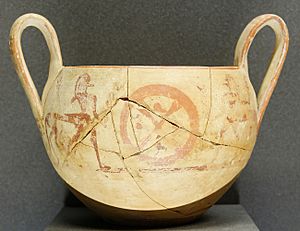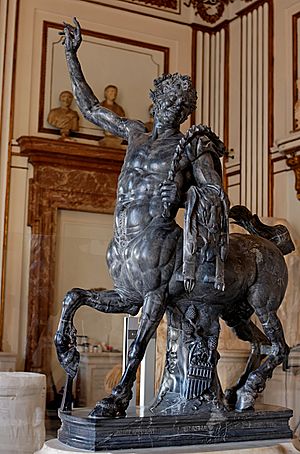Centaur facts for kids
A centaur is a fascinating creature from Greek mythology. Imagine a being that is half human and half horse! From the waist up, a centaur looks like a human, but from the waist down, it has the body and legs of a horse. There are also female centaurs in these ancient stories.
Some of the most well-known centaurs are Chiron, who was a wise teacher, and Nessus, who was known for causing trouble.
Contents
What are Centaurs?
Where did Centaurs come from?
In ancient Greek myths, centaurs were often said to be the children of Ixion and Nephele. Nephele was a cloud that looked like the goddess Hera. Another story says they were the children of a hero named Centaurus. This Centaurus might have been the son of Ixion and Nephele, or perhaps the son of the god Apollo and a woman named Stilbe.
In this second story, Centaurus had a twin brother named Lapithes. Lapithes was the ancestor of the Lapiths, a group of people who often fought with the centaurs. This means the centaurs and Lapiths were actually cousins!
Centaurs were believed to live in certain parts of ancient Greece. These places included the region of Magnesia and Mount Pelion in Thessaly. They also lived in the Foloi oak forest in Elis and on the Malean peninsula in southern Laconia.
Centaurs in Stories
Centaurs are often seen as creatures caught between two worlds. They have the wild, untamed nature of a horse, but also the intelligence of a human. This mix led to different stories about them.
Sometimes, centaurs were shown as wild and violent. A famous example is their battle with the Lapiths, where they fought fiercely. Other times, they were wise and helpful, like Chiron. Chiron was a famous teacher who taught many Greek heroes, including Heracles and Achilles.
Centaurs also appeared in Roman mythology and were common figures in medieval books about mythical creatures. Today, you can still find centaurs in many fantasy books and movies.
Centaurs in Ancient Art

We think centaurs might have been part of myths even in the Bronze Age. This is because some very old clay figures from that time look like centaurs. A painted clay centaur was found in a tomb at Lefkandi. By the Geometric period in Greece, centaurs were among the first figures painted on Greek pottery. You can see an old bronze statue of a warrior facing a centaur at the Metropolitan Museum of Art.
In Greek art, centaurs were shown in a few ways:
- Most commonly, they had a human upper body joined to a horse's body where the horse's neck would be. This is how we usually imagine them today.
- Sometimes, they had a human body and legs, but with the back half of a horse attached at the waist.
- A less common way showed them with human front legs that ended in hooves.
Later, some paintings on large pots called amphoras even showed centaurs with wings!
Centaurs were also popular in Roman art. A famous example is on the Great Cameo of Constantine, made around 314-316 AD. It shows centaurs pulling the chariot of Constantine the Great and his family.
Images for kids
-
Centaurs harvest grapes on a 12th-century capital from the Mozac Abbey in the Auvergne
-
Botticelli, Pallas and Centaur (1482–83)
-
A bronze statue of a centaur, after the Furietti Centaurs
See also
 In Spanish: Centauro para niños
In Spanish: Centauro para niños







